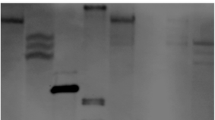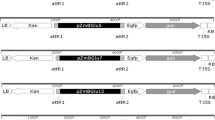Abstract
To avoid the unregulated overexpression of the exogenous genes, specific or inducible expression is necessary for some exogenous genes in transgenic plants. But little is known about organ- or tissue-specific promoters in maize. In the present study, the expression of a maize pentatricopeptide repeat (PPR) protein encoding gene, GRMZM2G129783, was analyzed by RNA-sequencing data and confirmed by quantitative real time PCR. The results showed that the PPRGRMZM2G129783 gene specifically expressed in vegetative organs. Consequently, a 1830 bp sequence upstream of the start codon of the promoter for GRMZM2G129783 gene was isolated from maize genome (P1830). To validate whether the promoter possesses the vegetative organ-specificity, the full-length and three 5′-end deletion fragments of P1830 of different length (1387, 437, and 146 bp) were fused with glucuronidase (GUS) gene to generate promoter::GUS constructs and transformed into tobacco. The transient expression and fluorometric GUS assay in transgenic tobacco showed that all promoter could drive the expression of the GUS gene, the − 437 to − 146 bp region possessed some crucial elements for root-specific expression, and the shortest and optimal sequence to maintain transcription activity was 146 and 437 bp in length, respectively. These results indicate that the promoter of the PPRGRMZM2G129783 gene is a vegetative organ-specific promoter and will be useful in transgenic modification of commercial crops for moderate specific expression after further evaluation in monocotyledons.









Similar content being viewed by others
References
Andrés-Colás N, Zhu Q, Takenaka M, De Rybel B, Weijers D, Van Der Straeten D (2017) Multiple PPR protein interactions are involved in the RNA editing system in Arabidopsis mitochondria and plastids. PNAS 114(33):8883–8888
Banks JA, Nishiyama T, Hasebe M, Bowman JL, Gribskov M, dePamphilis C et al (2011) The Selaginella genome identifies genetic changes associated with the evolution of vascular plants. Science 332:960–963
Bradford MM (1976) A rapid and sensitive method for the quantitation of microgram quantities of protein utilizing the principle of protein-dye binding. Ann Biochem 72:248–254
Christov NK, Imaishi H, Ohkawa H (1999) Green-tissue specific expression of a reconstructed cry1C gene encoding the active fragment of Bacillus thuringiensis delta-endotoxin in haploid tobacco plants conferring resistance to Spodoptera litura. Biosci Biotechnol Biochem 63(8):1433–1444
Cornejo MJ, Luth D, Blankenship KM, Anderson OD, Blechl AE (1993) Activity of a maize ubiquitin promoter in transgenic rice. Plant Mol Biol 23:567–581
Dai D, Luan S, Chen X, Wang Q, Feng Y, Zhu C, Qi W, Song R (2018) Maize Dek37 Encodes a P-Type PPR protein that affects cis-splicing of mitochondrial nad2 intron 1 and seed development. Genetics 208(3):1069–1082
Eckes P, Rosahl S, Schell J, Willmitzer L (1986) Isolation and characterization of a light-inducible, organ-specific gene from potato and analysis of its expression after tagging and transfer into tobacco and potato shoots. Mol Gen Genet 205(1):14–22
Filipovska A, Rackham O (2013) Pentatricopeptide repeats: modular blocks for building RNA-binding proteins. RNA Biol 10(9):1426–1432
Guillaumot D, Lopez-Obando M, Baudry K, Avon A, Rigaill G, Falcon de Longevialle A, Broche B, Takenaka M, Berthomé R, De Jaeger G, Delannoy E, Lurin C (2017) Two interacting PPR proteins are major Arabidopsis editing factors in plastid and mitochondria. PNAS 114(33):8877–8882
Han YJ, Kim YM, Hwang OJ, Kim JI (2015) Characterization of a small constitutive promoter from Arabidopsis translationally controlled tumor protein (AtTCTP) gene for plant transformation. Plant Cell Rep 34:265–275
Hou J, Jiang P, Qi S, Zhang K, He Q, Xu C, Ding Z, Zhang K, Li K (2016) Isolation and functional validation of salinity and osmotic stress inducible promoter from the maize type-II H+-pyrophosphatase gene by deletion analysis in transgenic tobacco plants. PLoS ONE 11(4):e0154041
Hsieh TH, Lee JT, Charng YY, Chan WT (2002) Tomato plants ectopically expressing Arabidopsis CBF1 show enhanced resistance to water deficit stress. Plant Physiol 130(2):618–626
Jiang SC, Mei C, Liang S, Yu YT, Lu K, Wu Z, Wang XF, Zhang DP (2015) Crucial roles of the pentatricopeptide repeat protein SOAR1 in Arabidopsis response to drought, salt and cold stresses. Plant Mol Biol 88(4–5):369–385
Kagaya Y, Nakamura H, Hidaka S, Ejiri S, Tsutsumi K (1995) The promoter from the rice nuclear gene encoding chloroplast aldolase confers mesophyll-specific and light-regulated expression in transgenic tobacco. Mol Gen Genet 248(6):668–674
Karim S, Aronsson H, Ericson H, Pirhonen M, Leyman B, Welin B, Mantyla E, Palva ET, Van Dijck P, Holmstrom KO (2007) Improved drought tolerance without undesired side effects in transgenic plants producing trehalose. Plant Mol Biol 64(4):371–386
Kyozuka J, Mcelroy D, Hayakawa T, Xie Y, Wu R, Shimamoto K (1993) Light-regulated and cell-specific expression of tomato rbcS-gusA and rice rbcS-gusA fusion genes in transgenic rice. Plant Physiol 102(3):991–1000
Lescot M, Dehais P, Thijs G, Marchal K, Moreau Y, Vande Peer Y, Rouze P, Rombauts S (2002) PlantCARE, a database of plant cis-acting regulatory elements and a portal to tools for in silico analysis of promoter sequences. Nucleic Acids Res 30:325–327
Li S, Sun Q, Hu M, Li S, Zhu Y (2012) Phylogenetic genome wide comparisons of the pentatricopeptide repeat gene family in indica and japonica rice. Biochem Genet 50(11):978–989
Li N, Chen J, Yang F, Wei S, Kong L, Ding X, Chu Z (2017) Identification of two novel Rhizoctonia solani-inducible cis-acting elements in the promoter of the maize gene, GRMZM2G315431. Sci Rep 7:42059
Liu Z, Dong F, Wang X, Wang T, Su R, Hong D, Yang G (2017a) A pentatricopeptide repeat protein restores nap cytoplasmic male sterility in Brassica napus. J Exp Bot 68(15):4115–4123
Liu YJ, Liu X, Chen H, Zheng P, Wang W, Wang L, Zhang J, Tu J (2017b) a plastid-localized pentatricopeptide repeat protein is required for both pollen development and plant growth in rice. Sci Rep 7(1):11484
Livak KJ, Schmittgen TD (2001) Analysis of relative gene expression data using real-time quantitative PCR and the 2−ΔΔCT method. Methods 25:402–408
Lurin C, Andres C, Aubourg S, Bellaoui M, Bitton F, Bruyère C, Caboche M, Debast C, Gualberto J, Hoffmann B, Lecharny A, Le Ret M, Martin-Magniette ML, Mireau H, Peeters N, Renou JP, Szurek B, Taconnat L, Small I (2004) Genome-wide analysis of Arabidopsis pentatricopeptide repeat proteins reveals their essential role in organelle biogenesis. Plant Cell 16(8):2089–2103
Lv HX, Huang C, Guo GQ, Yang ZN (2014) Roles of the nuclear encoded chloroplast SMR domain-containing PPR protein SVR7 in photosynthesis and oxidative stress tolerance in Arabidopsis. J Plant Biol 57(5):291–301
Mingler MK, Hingst AM, Clement SL, Yu LE, Reifur L, Koslowsky DJ (2006) Identification of pentatricopeptide repeat proteins in Trypanosoma brucei. Mol Biochem Parasitol 150(1):37–45
Miranda RG, McDermott JJ, Barkan A (2017) RNA-binding specificity landscapes of designer pentatricopeptide repeat proteins elucidate principles of PPR–RNA interactions. Nucl Acids Res. https://doi.org/10.1093/nar/gkx1288
Naimov S, Dukiandjiev S, Maagd RA (2003) A hybrid Bacillus thuringiensis delta-endotoxin gives resistance against a coleopteran and a lepidopteran pest in transgenic potato. Plant Biotechnol J 1(1):51–57
Odell JT, Nagy F, Chua NH (1985) Identification of DNA sequences required for activity of the cauliflower mosaic virus 35S promoter. Nature 313:810–812
O’Toole N, Hattori M, Andres C, Iida K, Lurin C, Schmitz-Linneweber C, Sugita M, Small I (2008) On the expansion of the pentatricopeptide repeat gene family in plants. Mol Biol Evol 25(6):1120–1128
Pan Y, Ma X, Liang H, Zhao Q, Zhu D, Yu J (2015) Spatial and temporal activity of the foxtail millet (Setaria italica) seed-specific promoter pF128. Planta 241:57–67
Stelpflug SC, Sekhon RS, Vaillancourt B, Hirsch CN, Buell CR, de Leon N, Kaeppler SM (2016) An expanded maize gene expression atlas based on RNA sequencing and its use to explore root development. Plant Genome. https://doi.org/10.3835/plantgenome2015.04.0025
Tan J, Tan Z, Wu F, Sheng P, Heng Y, Wang X, Ren Y, Wang J, Guo X, Zhang X, Cheng Z, Jiang L, Liu X, Wang H, Wan J (2014) A novel chloroplast-localized pentatricopeptide repeat protein involved in splicing affects chloroplast development and abiotic stress response in rice. Mol Plant 7(8):1329–1349
Tao YB, He LL, Niu LJ, Xu ZF (2015) Isolation and characterization of an ubiquitin extension protein gene (JcUEP) promoter from Jatropha curcas. Planta 241:823–836
Tavakol E, Sardaro ML, Shariati JV, Rossini L, Porceddu E (2014) Promoter analysis and expression profile of in response to drought stress in wheat ancestors. Gene 549:24–32
Voelker T, Sturm A, Chrispeels MJ (1987) Differences in expression between two seed lectin alleles obtained from normal and lectin deficient beans are maintained in transgenic tobacco. EMBO J 6:3571–3577
Wang H, Fan M, Wang G, Zhang C, Shi L, Wei Z, Ma W, Chang J, Huang S, Lin F (2017) Isolation and characterization of a novel pollen-specific promoter in maize (Zea mays L.). Genome 60(6):485–495
Wei K, Han P (2016) Pentatricopeptide repeat proteins in maize. Mol Breed 36:170
Xu R, Zhao H, Dinkins R-D, Cheng X, Carberry G, Li QQ (2006) The 73 kD subunit of the cleavage and polyadenylation specificity factor (CPSF) complex affects reproductive development in Arabidopsis. Plant Mol Biol 61(4–5):799–815
Zaidi M-A, Mohammadi M, Postel S, Masson L, Altosaar I (2005) The Bt gene cry2Aa2 driven by a tissue specific ST-LS1 promoter from potato effectively controls Heliothis virescens. Transgenic Res 14(3):289–298
Zhang H, Hou J, Jiang P, Qi S, Xu C, He Q, Ding Z, Wang Z, Zhang K, Li K (2016) Identification of a 467 bp promoter of maize phosphatidylinositol synthase gene (ZmPIS) which confers high-level gene expression and salinity or osmotic stress inducibility in transgenic tobacco. Front Plant Sci 7:42
Zhang YF, Suzuki M, Sun F, Tan BC (2017) The mitochondrion-targeted PENTATRICOPEPTIDE REPEAT78 protein is required for nad5 mature mRNA stability and seed development in maize. Mol Plant 10(10):1321–1333
Zhao J, Ren W, Zhi D, Wang L, Xia G (2007) Arabidopsis DREB1A/CBF3 bestowed transgenic tall fescue increased tolerance to drought stress. Plant Cell Rep 26:1521–1528
Zhou J, Yang Y, Wang X, Yu F, Yu C, Chen J, Cheng Y, Yan C, Chen J (2013) Enhanced transgene expression in rice following selection controlled by weak promoters. BMC Biotechnol 13:29
Acknowledgements
This work was supported by the National Key Science and Technology Special Project (2016ZX08003004-005) and the National Natural Science Foundation of China (31071433). The authors thank the technical support from Key Laboratory of Biology and Genetic Improvement of Maize in Southwest Region.
Author information
Authors and Affiliations
Corresponding authors
Ethics declarations
Conflict of interest
The authors declare that they have no conflict of interest.
Rights and permissions
About this article
Cite this article
Yu, H., Khalid, M.H.B., Lu, F. et al. Isolation and identification of a vegetative organ-specific promoter from maize. Physiol Mol Biol Plants 25, 277–287 (2019). https://doi.org/10.1007/s12298-018-0546-z
Received:
Revised:
Accepted:
Published:
Issue Date:
DOI: https://doi.org/10.1007/s12298-018-0546-z




